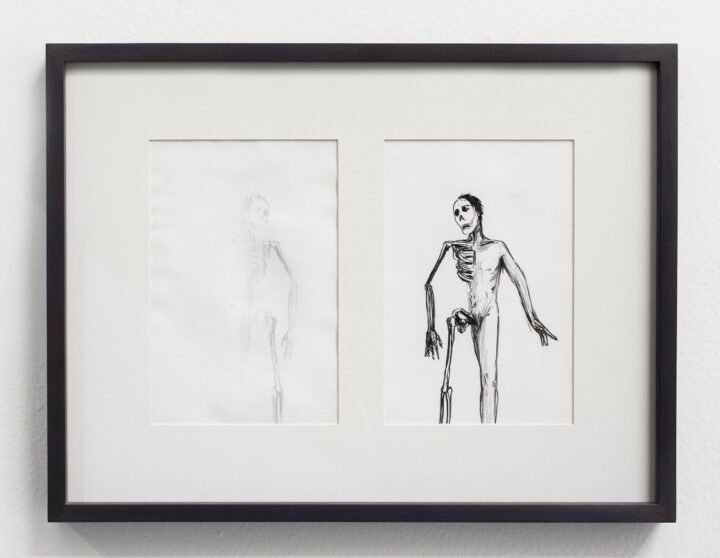Nació en Buenos Aires, Argentina, en 1977.
Estudió Bellas Artes en el Instituto Nacional de Artes Visuales (IUNA). Participó en diferentes becas de estudio nacionales e internacionales como la “Beca Kuitca”, en Buenos Aires; la “Scowhegan School of painting and sculpture”, en Maine, Estados Unidos y la “SAM Art Project”, en París, Francia.
Sus trabajos se despliegan en el límite entre las artes visuales y el teatro en formatos como instalaciones, esculturas, objetos o dibujos. Entre otras muestras colectivas, su obra participó en las bienales de Venecia (2015), Gwangju, Corea (2014); de Montevideo (2012), Lyon, Francia (2011), Mercosur, Brasil (2009); Pontevedra, España (2006)
Algunas muestras individuales recientes son: La Cabeza de Goliat, Usina del Arte, Buenos Aires (2018), Arena, MuBE – Museu Brasileiro de Escultura e Ecologia, San Pablo (2017), The End of Ending, Hirshhorn Museum and Sculpture Garden, Washington (2016), Teoría (La Cabeza de Goliath), Palais de Tokyo & SAM Art Projects. Paris (2014) y Nervio, Musée Départemental d’Art Contemporain de Rochechouart, Limoges, Francia (2013)
Desde 2003 forma parte del colectivo de artistas argentinos Provisorio/Permanente.
Vive y trabaja en Buenos Aires, Argentina.
Exposiciones individuales
2022
Pupila. Museo de Arte Moderno de Buenos Aires, Argentina.
2020
Free Will, PSM Gallery, Berlin, Alemania.
Shedding, Scrap Metal Gallery, Toronto, Canadá
2018
La Cabeza de Goliath, Musée d’Art Contemporain Les Abattoirs, Toulouse, Francia.
Perspective of Absence, site specific project for Art Basel Cities Buenos Aires, Asociación Argentina de Pesca, Caba, Argentina
La Cabeza de Goliath, La Usina del Arte, Buenos Aires, Argentina.
2017
Arena, MuBE – Museu Brasileiro de Escultura e Ecologia, San Paulo, Brasil
CasiNo / Sentido Único [One Way], Galeria Luisa Strina, San Paulo, Brasil
Remoto Control, Museu de Arte Contemporânea, Sorocaba, Brasil
2016
Capital, VNH Gallery. Paris, Francia
Eter, Ruth Benzacar Galería de Arte. Buenos Aires, Argentina
Incisivo, PSM Gallery. Berlin, Alemania
Lux, Provisorio – Permanente, Galería Nara Roesler. San Pablo, Brasil
2015
Mirar la obscuridad, Provisorio – Permanente, Ruth Benzacar Galería de Arte. Buenos Aires, Argentina
2014
Reflujo, Centro Cultural de la Memoria H. Conti. Buenos Aires, Argentina
Teoría (La Cabeza de Goliath), Palais de Tokyo & SAM Art Projects. Paris, Francia
2013
Nervio, Exhibición monográfica en el Museo Departamental de Arte Contemporáneo Chateau de Rochechouart. Limoges, Francia
Testigo, Galería Luisa Strina. San Pablo, Brasil.
2012
The End of Ending, PSM Gallery. Berlín, Alemania
2009
Todo lo contrario, Ruth Benzacar Galería de Arte. Buenos Aires, Argentina
2006
Cabeza rodante, Museo de la Universidad de Antioquia. Medellín, Colombia
Exposiciones colectivas
2022
Under Construction. Museo de Arte Contemporáneo Hamburger Banhof, Berlin, Alemania.
2021 – 2022
Reunión. Ruth Benzacar Galería de Arte, Buenos Aires, Argentina.
2020
Medium, Garzón Sculpture Park, Punta del Este, Uruguay
La Magdalena de Proust: Antropocentrismo Cotidiano, Max Estrella Gallery, Madrid, España.
2019
Recovering Histories, Recovering Fantasies, 2nd Bienal Sur, National Museum, Riyadh, Saudi Arabia
Immediately before and shortly after [curated by Heicke van den Valentyn and Cristina Sommer], Centro de Arte Contemporáneo Hotel de Inmigrantes, Buenos Aires, Argentina
Picasso et l’Exil, Musée d’Art Contemporain Les Abattoirs, Toulouse, Francia.
Secretos Compartidos, Centro Cultural Borges, Buenos Aires, Argentina.
2018
O Lugar do Centro [The place of the center], Central Galeria, San Pablo, Brasil
2017
Parientes, Centro Cultural Parque de España, Rosario, Argentina
Como un Destello, Casa del Bicentenario, Buenos Aires, Argentina.
2016
Secret Surface, KW Institute for Contemporary Art. Berlin, Alemania
Hacking Habitat. Utrecht, Holanda
The End of Ending en “Masterworks for the Hirshhorn Collection”, Adquisición del Hirshhorn Museum and Sculpture Garden. Washington, Estados Unidos
2015
Risk, Turner Contemporary. Margate, Inglaterra
My Buenos Aires, La Maison Rouge. Paris, Francia
XII Bienal de La Habana. Havana, Cuba
All the World’s Futures, 56th Venice Biennial. Venice, Italia
2014
Teoría, Musée de Bellas Artes de Montréal. Montréal, Canadá
La Isla, Gwangju Bienal. Gwangju, Corea del Sur
El Silencio de las Sirenas, Museo de arte moderno. Mar del Plata, Argentina
Reflujo, Centro Cultural de la Memoria H. Conti. Buenos Aires, Argentina Eyelids, OK Center for Contemporary Art. Linz, Austria
Teoría, Fundação Calouste Gulbenkian. Lisboa, Portugal
La Caída, “Beyond Magic, Ruth Benzacar @ Xippas”. Paris, Francia Dreamer’s Field, Project Frieze New York. Nueva York, Estados Unidos
2013
Salvador, “Of Bridges & Borders”, Valparaiso, Chile. La fuga, Project ParC Fair. Lima, Perú
Solo-booth, Ruth Benzacar Galería de Arte, Art Basel Miami. Miami, Estados Unidos
2012
Salon Fumador, Bienal de Montevideo. Montevideo, Uruguay
Art Parcours, Art Basel. Basel, Suiza
Mapas Invisibles, Luis Adelantado Gallery. DF, Mexico
U-turn Project Rooms, arteBA. Buenos Aires, Argentina
2011
El Silencio de las Sirenas, Bienal de Lyon. Lyon, Francia
Endogenous, Maria Stenfors. Londres, Inglaterra
Sky, PSM, FIAC. Paris, Francia
Aire de Lyon, Fundación PROA. Buenos Aires, Argentina
2010
One Way, “The Traveling Show”, Fundación Jumex. DF, Mexico Panamericana, Kurimanzutto. DF, Mexico
Of Bridges & Borders, Centro Cultural de España en Buenos Aires. Buenos Aires, Argentina
Narrativas Inciertas, Museo de Arte Moderno de Buenos Aires. Buenos Aires, Argentina
2009
Cíclope, Bienal del Mercosur. Porto Alegre, Brasil
2008
Southern Exposure, Dumbo Art Center Brooklyn. Nueva York, Estados Unidos
Museo Salvaje, Centro Cultural de España in Buenos Aires. Buenos Aires, Argentina
2006
El Camino del Zorro, Bienal de Pontevedra. Pontevedra, España
Colecciones
Hirshhorn Museum and Sculpture Garden, Washington, EE.UU.
Musée d’Art Contemporain de Lyon, Francia.
Musée des beaux-arts de Montréal, Canadá.
Musée d Art Contemporain de Rochechouart, Francia.
Musée d’Art Contemporain Les Abattoirs, Toulouse, Francia.
Musée d’Art Contemporain FRAC Corsica, Francia.
Adrastus Collection, Arevalo, España.
Juan e Patricia Vergez, Buenos Aires, Argentina
Tiroche de Leon Collection, Israel
CiFo, Cisneros Fontanals Art Foundation, Miami, EE.UU.
Banco Supervielle, Buenos Aires, Argentina























